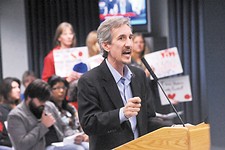Designed To Fail
As AISD contemplates repurposing Pearce Middle School – again – is the district promoting single-sex trends at the expense of current students?
By Richard Whittaker, Fri., Nov. 18, 2011
It is early afternoon at the James E. Pearce College Preparatory Academy. In the main office, a grandfather is worrying about his granddaughter. He has been dropping her off at 6:30 in the morning, but the school is telling him that she is tardy when the bell rings at 8:10. The issue is the three-minute gap between classes: She is taking too long between classrooms, and that goes down as a tardy, just like being late for assembly. This is all part of the new, tougher, and more rigorous regime under Principal Texanna Turner, the person assigned to make every Pearce student college-ready by the time he or she graduates. Three months ago, Turner did not even have a real sign outside of her campus, just a banner. Now she has a sign, a full campus, a new academic model, and a lot of community good will.
So why is the district administration already talking about pulling the plug and turning Pearce into a single-sex academy?
Depending on whom you ask, Pearce is one of three things. It's the campus that the Austin Independent School District just cannot fix. It's the campus that the Texas Education Agency loves to beat up. Or it's a beloved neighborhood school.
In fact, it is all three. The middle school campus has been classified as "academically unacceptable" six of the last eight years – but that is in a context of shifting and ever-toughening Texas Education Agency regulations. Staff members who were helping turn the school around were dumped in 2009 under a TEA-inflicted repurposing, and the campus has been in a wild state of flux ever since. Last year, under Principal Trana Allen, it held only seventh and eighth grades. Now Allen is gone, last year's students were packed off to other campuses – including a hybrid eighth-grade academy at Reagan High – and Pearce is filled with sixth and seventh graders who have never been on a middle-school campus before. Yet Turner is optimistic about this new start. "It was so exciting," she said about the first day of the semester. "I remember we all met in the cafeteria to have breakfast, and then we went to the gym and had what we call a 'scholar walk.' I called on each feeder school. 'So if you're an Andrews Alligator, stand up' – and then I thanked them for being there and told them the scores they were bringing to this campus." The purpose, Allen continued, "was to show them that they were the crew to change the stigma. ... 'You're going to be the ones to make this district see that this is a great school.'"
And the new crew is not only the students – the Pearce of 2011 is not the Pearce of 2010. The building may look the same, but it has none of the same teachers, almost none of the same staff, and a completely new cadre of students. Even before people knew what Turner was planning, there was one big sign of community support for the new-look school. She had expected 175 sixth-grade kids on opening day and had staffed accordingly. She actually got 210, plus 169 seventh graders. "We ended up hiring a new sixth-grade science [teacher] and a sixth-grade social studies teacher," Turner said, but that still left her contending with large class sizes. After the district gutted its work force in response to state budget cuts, AISD's new target teacher-student ratio is 29-to-1 – but, Turner said, "I don't want a math class that large." Her solution was to reclassify her math specialists – intended to be support staff for struggling students – as classroom teachers, so now "instead of having two math teachers for sixth grade, I have four." There are more pre-Advanced Placement classes, and she's even trying to rip the stigma from special education. Rather than having the kids who need a little more help shipped off to a special class, the tutors are coming into the classrooms. She said: "If you're the sixth-grade special education teacher that supports that class, this is your class, too. Both of you are the teacher of record."
But there is a shark swimming in Pearce's now calmer waters – and it is the threat of being turned into a single-sex campus. In typical contemporary AISD fashion, there has been a nonconversation going on that dates back to June 20, when Superintendent Meria Carstarphen made an oblique reference to potentially turning both Pearce and Garcia middle schools into separate boys' and girls' schools (see "'Are We Having Fun Yet?,'" Newsdesk blog, June 20). After months of speculation, that conversation finally surfaced publicly at the AISD board of trustees work session on Monday, Nov. 7, when trustees received a presentation from the administration with very specific details. What is being touted is two single-gender middle schools, each holding 650 students. Their combined attendance zones would cover much of East Austin, mapping almost precisely the Pearce and Garcia boundaries, plus part of Dobie's footprint. In a gung-ho presentation, district staff argued a cornucopia of benefits, from gender-specific education models to better role models. The plan would not come cheap: While much of the $10 million first-year operation budget will be offset by reallocating existing resources and programs, the district will still be looking for a million dollars in external funding to cover start-up and facilities costs.
Turner has dealt with problem schools before and knows what it takes to turn them around. She said, "I was principal at Sims [Elementary School] when we were on the roller coaster, up and down, up and down ... but it was three to five years before we got to the point where I could say, 'What we have works.'" And she fears that families may not believe that this is the real reform package: Since the school year began, parents have approached her about the rumors of Pearce getting overhauled yet again. "They are afraid," she said. When they've asked her about the single-sex school rumors, she said: "My answer to them is that I truly don't know. I just tell them that we have to be ready for whatever comes."
No one is really happy about the historic situation at either Pearce or Garcia, as both campuses have been regularly classified as "academically unacceptable." Associate Superintendent of Middle Schools Bergeron Harris called East Austin "a community that I want to say perceives that they've been neglected in the system for quite a while, but I think that I can take out the word 'perceives.'" He has been on the ground for some of the worst years for Pearce, and one of his first tasks as middle school chief was to implement the 2009 reconstitution plan. "When you go over to Pearce now, you see and you feel the impact of some very thoughtful plans," he said. But if the district is still midway through a three-year reform cycle and everyone is looking for green shoots, why is the administration already talking about another change of direction?
Stuck in the Middle
The district is actually considering a total of four single-sex academies. In addition to Pearce and Garcia, there is already the Ann Richards School for Young Women Leaders, and now the district has a $4.6 million grant from the Moody Foundation to explore opening a School for Young Men, covering grades six through 12. Such grants drive the conversation in subtle and not-so-subtle ways, and even the terms of public discussion. Harris said: "We're playing with the term now. We said 'single-gender,' and today in a meeting we said 'single-sex.'" In part, that language is driven by whichever big grant is on the table today and whatever name a potential donor feels easiest with.
The mantra from the board and the administration remains the same: They're "just talking," just "spit-balling ideas," just "making backup plans" in case the current system does not work. But district families have been burned on district plans before and have shown little patience for adding single-sex schools. A misguided attempt in 2007 to convert Webb Middle School into a boys' academy delivered former Superintendent Pat Forgione his most embarrassing defeat (see "Forgione's BEST-Laid Plan for Closing Webb," Feb. 16, 2007). However, Harris argued that times and moods have changed. Single-sex schools "are popping up in different places," he said. "Previously I don't think we had a lot of examples, but with the advent of charter schools and people being open to new designs, we hear now about all the different single-gender, mostly male academies and the successes they're touting."
However, single-sex schools are not the only alternative being touted as a replacement for traditional coed public schools, and it seems like middle schools are the simplest and easiest targets for such experiments. After all, elementaries and prekindergartens are too busy handling educational basics to see much reform, and high schools are caught up in remediation and college prep, so middle schools are the easiest place to tinker with the program. Moreover, if TEA stats are anything to go by, then middle schools are the problem child of AISD. Of 18 middle schools, six were classified as "academically unacceptable" this year, compared with only two of the district's 16 high schools. While district administrators perpetually argue that elementaries are where the trouble starts, every single AISD elementary is at least "academically acceptable," and elementaries account for the overwhelming majority of the district's "exemplary" campuses – the TEA's highest accolade. So what is the difference between middle and elementary schools? "It's called the 'building change effect,'" explained Harris. "They leave one school setting and they go to another, [and] there tends to be an academic dip." If things are going to go wrong for students, it seems that middle school is where it starts. In AISD, that problem puts the spotlight on Harris, and he has theories as to why sixth grade is such a problematic transition. He said: "People see middle school and everyone goes, 'Uuuuh!' It's not because of middle school. They think about adolescence and their experience of adolescence."
Indeed, the teenage transition has real academic consequences. Turner is dealing with some seemingly anomalous statistics – not least that her kids whose sixth grade stayed with their elementary scored better than the kids who went straight into middle school. If those numbers stand up, then that could have dramatic consequences for how AISD splits school ages. Traditionally, middle schools have been just for sixth through eighth grades: Now Pearce is sixth and seventh grades, Garcia is seventh and eighth, and Ann Richards goes from sixth to 10th. However, 14 of AISD's 80 elementary schools hold on to their sixth graders, and AISD is already looking at a K-through-eighth school model. Harris said he has even seen positive research on moving ninth grade back to middle school.
Unfortunately, that research casts a strange pall over the district's decision to house Pearce's eighth graders at Reagan High in an 8th Grade College Prep Academy. The eighth grade staff was recently told to consider this a part of Reagan, but the integration is far from complete. Classes are taught in whatever space is available, and their numbers are so small that they are often overstretched on such seemingly simple tasks as taking children to and from lunch. Extracurricular activities, if they are provided, occur over at Pearce. For all the talk of this being a Reagan facility, many students will transfer to LBJ next year, increasing the sense of impermanence. Staff members, some of whom were hired only days before the start of the new school year, have no reason to feel secure in their jobs: Next year, Pearce will take its eighth grade back, and these teachers have no guarantee they'll be going with it.
To Harris and the district, these years of grade flux at Pearce are "breathing room." But to students, staff, and families, they represent just another chapter in the chaotic ride at Pearce, and surrounding schools are feeling the collateral damage. Last year it was the elementaries that had to absorb Pearce's sixth graders; this year it is Reagan with an influx of eighth graders. That means hiring staff, finding space, rescheduling lunch times. If Pearce and Garcia go single-sex, then Dobie and Webb will absorb those students who prefer to attend a coed middle school. That would be another round of logistical headaches – not least that there would be no mixed middle school in most of East Austin. A parent currently able to walk her child to Overton Elementary would face a 12-mile round trip to the nearest coed middle school. Turner is meeting regularly with administrators throughout the combined Reagan/LBJ Vertical Team, making sure her kids are really ready for high school, but she's already more than aware how changes in one school can reverberate through every neighboring campus. She said: "When we chose to reopen Kealing to have another neighborhood school and it morphed into something completely different, and when they moved the Liberal Arts Academy to LBJ, look at what it did to the new Eastside. Those are just domino effects."
However, Harris believes the district can convince parents that change is not only in their best interests, but it really is not change at all. He said: "We said at Pearce we were going to build an early college prep model, and that's what we're doing. ... Whether it's a single-sex school or not, it would still be a college prep academy."
Single Sex, or Magnets in Disguise?
While no firm decision has been made about locations for additional single-sex schools, board President Mark Williams said: "There are some likely candidates. When you think about these ideas, certain schools might come to mind as making more sense than others." Williams said he would want "a pretty strong business case analysis" that would address any concerns about board and community buy-in, "and that's where the challenge of time would come in." With the board expected to vote on Carstarphen's initial round of annual facility recommendations in a month, Williams said he doubted big changes for Pearce or Garcia would be likely for the 2012-13 year: However, that doesn't mean there could not be a vote for the 2014 or 2015 years.
For board Vice President Vince Torres, the board may have more than enough on its plate for 2012. Even without a single-sex push, the trustees are likely to be mulling proposals for two-way dual language programs and a charter school contract for Eastside Memorial (see "Not Everyone Keen on Charter IDEA," Nov. 11) at their Dec. 12 work session. And for Torres, even as an alumnus of the then-all-male U.S. Naval Academy, the jury is still out on single-sex academies, though he did note that they may provide "the environment that some students are not going to find in a standard school."
Political pressure and district enthusiasm about single-sex schools notwithstanding, their growth may come down to one simple question: Do they work? AISD has become very defensive on that issue. On Oct. 6, the district's Department of Public Relations & Multicultural Outreach issued a statement declaring, "To be clear, the Ann Richards School (ARS), and many other diverse single-gender schools across the country, have exceptional outcomes." This, the statement continued, was to counter "research [that] may confuse the community about the effectiveness of single-gender education."
That was a direct shot at one of the district's oldest and strongest allies in academic reform, the University of Texas, and in particular a paper in the journal Science titled "The Pseudoscience of Single-Sex Schooling." Co-authored by UT psychology professor Rebecca Bigler, the paper was a review of the entire body of research on single-sex schooling. AISD did not respond to our request for comment. Bigler's findings were stark: That neither neurological studies, qualitative research, nor grade reports show any validity to the concept of "gender-specific learning styles," and that reported improvements in performance might be due to academies cherry-picking students, contrary to the stated policy.
Bigler told the Chronicle, "It's very fashionable to put boys and girls in [functional magnetic resonance imaging] machines and say boys' brains are different to girls' brains, but a lot of that research has failed to be replicated." In fact, her report concluded there's evidence that by splitting boys from girls, "gender divisions are made even more salient" in students' minds, and that the political allure of single-sex schools disguises and reinforces institutionalized sexism. Rather than fencing teenagers off from each other, Bigler said, "We argue that boys need to learn as well as girls need to learn that sexual harassment is inappropriate."
For the district, the most controversial aspect of Bigler's research was another paper she and two of her colleagues wrote for Sex Roles: A Journal of Research, called "The Efficacy of Single-Sex Education: Testing for Selection and Peer Quality Effects." The report focused on an unnamed "public single-sex middle school in the Southwest United States," but district insiders quickly realized that the authors were talking about AISD's original single-sex academy, the Ann Richards School. The study compared the reading and writing scores for three groups: 121 girls who successfully applied to the campus, 229 unsuccessful applicants, and 134 girls attending a coed magnet. When comparing grade improvements from the single-sex academy and the coed magnet, the authors concluded that "it is overall peer quality, rather than the gender composition of the schools, that explains single-sex school students' outperformance of coeducational school students." For AISD, the real bombshell was in the comparison between successful and unsuccessful applicants. The district has always claimed that it runs a simple lottery system for Ann Richards, with all applicants having an equal chance of getting in. Yet the report showed that successful applicants were already outscoring the unsuccessful applicants in the fifth grade tests. If the school is snagging the best applicants, is it any surprise they outscore their peers?
Asked about Bigler's research, AISD did not directly address the admissions questions, but said, "Ann Richards shows larger growth than most campuses and is, in fact, among the highest performing schools."
With all the research and rumors and grant proposals in the air, the only thing Turner can do is run her school. Now that she knows how many students she has and knows their Texas Assessment of Knowledge and Skills scores, she has screened every student in math and reading so she can transition them into next year. "I walked around when they were taking those tests," she said, "and they did a really good job. They worked hard." Similarly, she's studying her staff, seeing which ones she may want to move to handle the new eighth grade. With an extra grade's worth of students in the fall, she is already planning how she will allocate rooms for next year. That means un-mothballing whole wings of the campus – some parts of which have been locked up for two years. That means planning and budgeting now – presuming that Pearce will still be Pearce in one or two or three years' time. She said, "All I want to make sure is that, whatever happens, we do a good job this year."
Got something to say on the subject? Send a letter to the editor.














